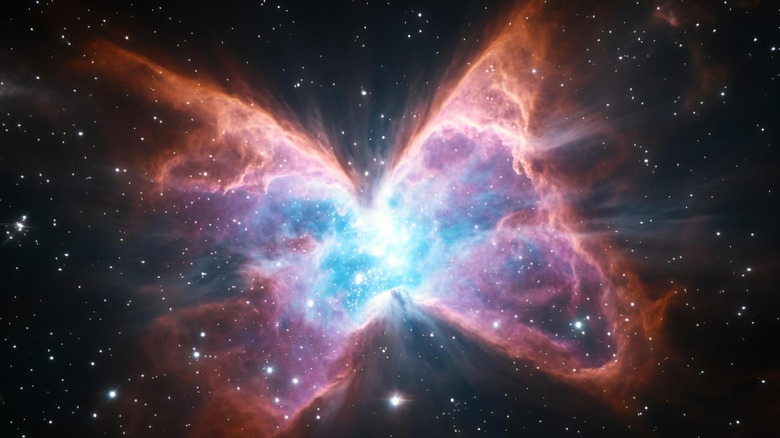Astronomers Say This 'Cosmic Butterfly' Might Explain How Our Planet Formed
When we start talking about Earth's origin, there are many theories on the table that have been tossed around for years, with the Big Bang hypothesis often leading the charge. But thanks to the James Webb Space Telescope, scientists have homed in on some new information that may help to illuminate how planets like Earth came to be. The new string of clues was uncovered by a team of researchers who were studying imagery of the "cosmic butterfly" — officially referred to as the Butterfly Nebula or NGC 6302 — a planetary nebula close to 3,400 light-years away from our home planet, hanging out in the Scorpius constellation. The team's findings were published in the Monthly Notices of the Royal Astronomical Society.
So, how does this all tie back to the origins of Earth and similar planets? The "cosmic butterfly" is actually a collection of cosmic dust, made up of microscopic organic material and minerals that are the building blocks of planets and life. By analyzing the composition of ions and molecules in the nebula, researchers can now see how these elements and organic compounds — the literal bedrock of rocky planets — can form from the dying gasps of a star.
In the case of our planet, heavy metals like iron and nickel are the foundation of Earth's core, oxygen-rich molecules make up our crust, and carbon-based molecules act as the building blocks for the life on the surface. JWST has found all of these in the Butterfly Nebula. These discoveries reinforce the idea that planets like Earth are assembled from recycled stellar material, shaped by the same elemental processes we can see taking place in nebulae like NGC 6302.
How a dusty torus shapes the cosmic butterfly
The extremely warm star at the center of the Butterfly Nebula (with a temperature of 39,490 degrees Fahrenheit) is the main reason the nebula glows so brightly, but the James Webb imagery is leading researchers to believe that the dense belt of dusty gas — or torus — surrounding the Butterfly Nebula's once-elusive central star may provide a line of cosmic breadcrumbs back to the processes that birthed Earth-like planets. And we say "once-elusive" because it wasn't until the Webb's Mid-Infrared Instrument delivered this recent batch of camera and spectrograph data that scientists were able to see past the powerful glare of the nebula's outer regions.
Some of the new data revealed that the Butterfly Nebula's torus is made up of crystallized silicates including quartz (minerals abundant in Earth's crust) and irregularly-shaped dust grains measuring about one millionth of a meter. That sounds very tiny, but when talking in terms of galactic history, that micrometer particle size is actually pretty big, and indicates the dust grains have been growing for a long time.
Scientists are also thinking the dusty torus around NGC 6302's central star may be at the root of the nebula's insect-like appearance (its two lobes spread out to form "wing-like" structures, while the torus acts as the butterfly's "body"). The theory: All that quartz and dust in the belt may be preventing the wing-forming gases — like hydrogen and helium — from flowing outward in all directions uniformly.
Layered dust, heavy metals, and the blueprint for Earth
The Webb data also reveals that, outside the torus, the atoms and molecules of NGC 6302 take on a multilayered structure, in which ions that require the most energy are situated close to the nebula's center, while those that require less are located farther from the central star.
Elements like iron and nickel, as well as carbon-based molecules called polycyclic aromatic hydrocarbons, were detected by the Webb scans, too, suggesting a type of historical mockup where both organic compounds and heavy metals coexist. But inherent to the nature of all nebulae, eventually, both metals and organics are gradually ejected into space as the building blocks for new cosmic activity.
In this way, the Butterfly Nebula serves as a kind of astral time capsule, showing how matter is recycled across stellar generations. The same mix of metals and organics released from the cosmic butterfly mirrors the ingredients that once seeded our own solar system, which set the stage for Earth's eventual formation.


